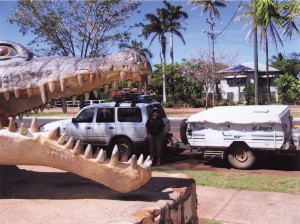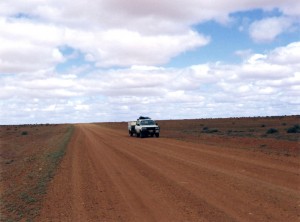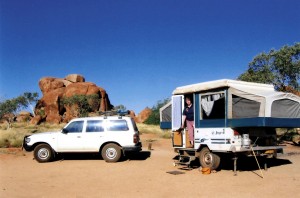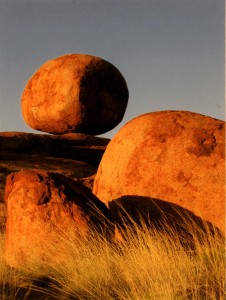DOWN UNDER IN THE TOP END – PENELOPE HEADS NORTH
By Tim Bowden
Australia’s tropical north, now the nation’s most popular tourist destination for overseas visitors as well as locals, was not always so highly regarded. It was even alleged in 1942 during World War II that in the event of a Japanese invasion, the whole of the north was to be abandoned to the invaders. (This was later denied by the Liberal government of Robert Menzies.) The Labor Party’s Eddie Ward alleged that evacuations and a scorched earth policy would be carried out down to the ‘Brisbane line’ which was to be held after more than half of continental Australia was written off!
The interior of Australia, once optimistically thought to contain an inland sea, is in reality only a sea of sand and some explorers who sought to penetrate its vast arid areas to reach the north died. Burke and Wills perished at Cooper’s Creek in 1860 from a combination of bad luck and incompetence, and Edward Kennedy was speared by hostile Aborigines in remote Cape York Peninsula in 1848.
With torrential rain in the ‘wet’ season, and fierce heat in high summer, Australia’s north is a potent manifestation of the poet Dorothea Mackellar’s ‘sunburnt country’ with its ‘droughts and flooding rains’. She noted also that her much loved ‘wide brown land’ was not without ‘her beauty and her terror’. In more recent times the ‘terror’ of Australian travel was made much of by writer Bill Bryson who claimed Australia was the most dangerous country he had ever visited: you could be dispatched by a long list of deadly creatures including poisonous snakes, spiders, crocodiles, box jellyfish, sharks – and even a seashell that would attack you.
Fortunately, Bryson has been unable to dissuade hordes of overseas visitors from roaming northern Australia, climbing Ayers Rock (Uluru), riding camels, diving on the Barrier Reef, marvelling at Aboriginal rock art, cruising on Kakadu’s incomparable wetlands, soaking in thermal springs and watching crocodiles in wild life enclosures leap high into the air to take chunks of meat offered to them via a very long pole.
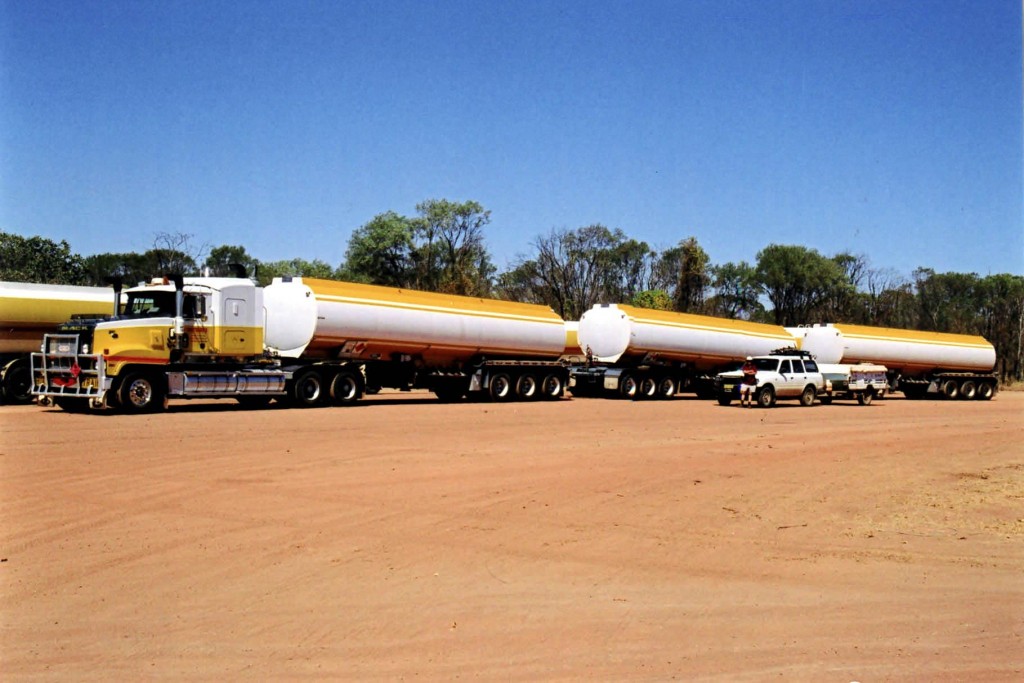
Size isn’t everything… Penelope and The Manor dwarfed by a road train on the Stuart Highway, Northern Territory.
When my wife Ros and I first ventured forth in our elderly split-screen Kombi and trailer in 1974, travel in the Northern Territory was not for the faint-hearted – even in the cooler dry season. The Stuart Highway was unsealed from Port Augusta in the south, to Alice Springs. Navigating the red-rutted track with huge, seemingly bottomless pot-holes full of ‘bull dust’ (a white substance of talcum powder texture with an ability to penetrate almost anything but a capped bottle of beer) made it too dangerous to take your eyes off the road to even snatch a quick look at the surrounding countryside. Such reminiscences must seem inexplicable to today’s tourists who speed along the wide, sealed motorway through the desert in air conditioned luxury. And speed they have been able to, because until 2006 there was no speed limit in the Northern Territory. In the 1970s relatively few tourists made it to Uluru or Kings Canyon because of the unsealed roads.
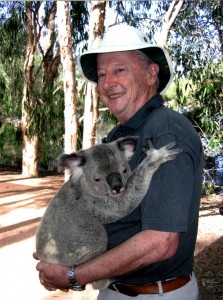
Cuddling koalas isn’t at the top of my ‘must do’ list, so I’m not quite sure why I posed for this photograph at the Billabong Sanctuary, Queensland. The rather cheesy, strained smile is because the koala had one of its largest claws wedged in my navel.
Unbelievably, Territorians in the late 1960s and early 1970s were faintly resentful of tourist visitors and let us know it, but that was soon to change. In the twenty-first century tourism in Australia is booming. And Australians are traveling widely within their own country, partly due to the uncertainties brought about by terrorism and instability around the world, but also through a desire to experience their own ‘wide brown land’.
A large proportion of these home-grown travellers are older Australians more of whom are taking to the road every year – who have become known as the ‘grey nomads’. One report I saw said there were about 80 000 caravans doing ‘the big lap’ around Australia at any one time. Another made it 15 000 RVs (recreational vehicles). Both sources agreed that there were at least 350 000 registered RVs in Australia, some clearly resting between engagements. After a curious dip in the early 1990s (perhaps the cashed-up middle class tended to head off overseas or to local resorts for their holidays) the RV industry started to pick up again. It flourished (particularly for the baby boomers) after the terrorist attacks in New York on 11 September 2001 (and beyond) when overseas travel seemed less attractive than boiling the billy under a friendly Australian gum tree.
It would be wrong to categorise all these wanderers as grey nomads. Young tourists from overseas and Australian couples and families have rediscovered the simple pleasures of driving and camping in campers and motor homes. But 70 per cent of those living on the road are the over fifty-fives.
To gather material for our fourth Penelope book, we planned a three-month journey north to Darwin and back to New South Wales via Alice Springs, the Oodnadatta Track and Arkaroola, we were already aware (both being on the wrong side of sixty-five) that opportunities to hit the road for three months should be grabbed eagerly (a) while we could manage the journey and (b) while we wanted to. Both our respective fathers died in their early nineties and we knew that their expectations of life had diminished over time. Ros’s father’s main preoccupations in his nursing home were to have a box of man-sized tissues beside his bed and plenty of his favourite fruit-flavoured jubes beside the jumbo Kleenex. Much, we felt, remained to be done and seen before our focus narrowed to that extent.
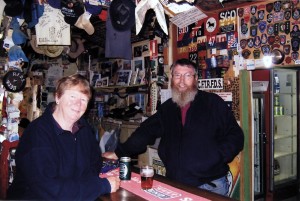
Ros enjoying a reviving ale at the bar of the William Creek Hotel with recent arrived publican John Sheedy, on the Oodnadatta Track. The Sheedys’ arrival boosted the William Creek population to ten.
Happily, exploring Australia by camping and driving was not a new activity for us. In 1974 I took long service leave from the Australian Broadcasting Commission and with our then sixteen-month-old son, Barnaby, took off in our Kombi van, towing a trailer, for a seven-month journey up the east coast of Australia to Cairns (and Cooktown), across to the Gulf Country, over the Barkly Tablelands to Tennant Creek in the Northern Territory, then up to Darwin.
We drove down the Stuart Highway first to Alice Springs then further south to Port Augusta on the previously mentioned unsealed section. We saw and climbed Ayers Rock – not then widely known as Uluru – and went on to Adelaide, Melbourne, and Tasmania.
More recently the idea began to take root in our minds that we should retrace our steps to Darwin in 2005, three decades after our first journey there.
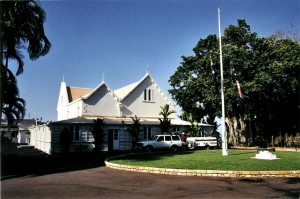
Darwin’s historic Government House, where the Bowdens had their most luxurious ‘camp’ of their trip, courtesy of the then Administrator His Honour Ted Egan AO and his partner Nerys Evans. We slept in the Queen’s Bedroom no less…
There is an endless fascination in seeing how other people undertake their journeys – in motor homes, caravans, and campers towing their accommodation. Others, like tortoises, carry their bedrooms on their backs driving campervans or great lumbering motor homes. Others in four-wheel drives (4WD) have elaborate tent arrangements which burst forth from their roof racks, but those who plan really off-the-beaten-track excursions across the Simpson Desert do not tow anything and make do with basic fold-away tents, their roof racks festooned with extra tyres and fuel and water jerry cans. Camper trailers range from metal encased juggernauts (reminiscent of armoured personnel carriers) to less macho but still robust wind-up campers, with beds pulled out from each end. This is the style we favoured when we graduated in 1997 from our Kombi days. Folded up, the camper resembles a big, high trailer, and is relatively easy to tow. You can have off-road versions too, with a heavier chassis and high clearance, which was our choice. When you wind the camper up and pull the beds out from each end, the space inside seems to expand exponentially, like Dr Who’s Tardis.
Our Jayco Flight camper, The Manor, (for to travel in her is to be ‘to the manor born’) is towed by our trusty Landcruiser, dubbed Penelope. The Manor is an off-road camper which we have taken into some quite remote and difficult locations over the years. For instance, we negotiated high-banked creeks and steep stony tracks to get into the Bungle Bungles (Purnululu National Park) in the Kimberley region of Western Australia where towing anything is not recommended. There is, of course, a robust debate about the benefits or otherwise of towing. We rather like going somewhere, establishing a camp, and then being able to drive away from it, possibly into areas where we would hesitate to take The Manor. Those who have their houses on their backs have to break camp and take the whole lot with them even if they only need to drive a short distance to pick up some milk or fresh supplies. Others say they would rather stick sharp tent pegs through their insteps than tow a trailer or indeed a caravan.
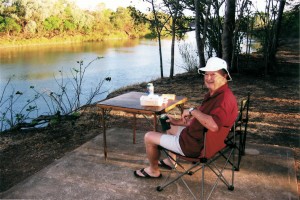
Admirable waterfront real estate, camping beside the Daly River on Dick and Carol Perry’s mango farming and barramundi fishing establishment in the Northern Territory.
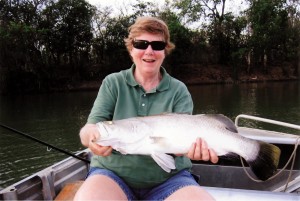
Ros, obviously delighted with the splendid barra she caught on Dick Perry’s private billabong. We shared it with Dick and Carol of course!
It has to be said that I am not handy when it comes to mechanical or auto-electrical mishaps. Fortunately, in outback Australia, there are lots of people who are, even fellow-travellers, who can be frighteningly competent in these areas and seem more than happy to help out. Some even carry portable welding outfits in their rigs.
In my own defence I do try to make sure that everything is checked and working properly before we go, and I do carry extra spares – particularly fan and engine belts, radiator and fuel hoses and a modest toolkit. The Manor and Penelope’s wheels are interchangeable, and there are spare tyres for each. On the occasions when I have needed to change a wheel, I have borrowed the spare from the camper because you have to have a degree in practical engineering to recover the Landcruiser’s spare tyre. The spare is suspended under the rear of the vehicle and retrieving it is a complex procedure calling for considerable dexterity and the type of patience I do not possess even though I’ve managed it when I had to. (Necessity, as they say, is the mother of invention.)
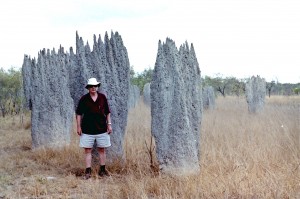
Magnetic termites nests in Litchfield National Park, Northern Territory. The thinner edges face due north and south. The termites cleverly manage temperature control by so constructing their colonies.
In fact, tyres can be the most vulnerable aspect of out-back driving. Before a major trip (we have 16 inch split-rim tyres) I always put in new inner tubes and, if there is any obvious wear, put on a new set of tyres. I get the wheel bearings of The Manor examined and repacked, and the electric brakes and shoes checked over.
Penelope, for the record, is a Series 80 diesel Toyota Landcruiser, made in 1994. Because she is only really used for camping trips, the odometer had not yet turned over 200 000 kilometres in 2005 which, for that style of vehicle, is exceedingly modest. To make extra space for stores, luggage, and essentials like the wine-cellar, I took out the back seat and moved the cargo barrier forward to just behind the two front seats, using fishing boxes as storage bins. (I am capable of doing this myself – just.) We have a small three-way fridge of uncertain ancestry which I screwed down to the floor of the cargo space at the back where there are rear-facing drawers for essentials like tools, trailer hitching arrangements, an axe, folding barbecue, a small floor-jack, wire, gaffer tape, ropes etc. This little fridge can be operated on battery power and in addition to the modest fridge in The Manor, served as a kind of superior Esky, providing cold drinks and keeping our lunches cool. We have an auxiliary battery fitted to the Landcruiser which powers the fridge, and there is also a lead that can take 12 volt power back into The Manor for lighting and to power a CD player (iPod these days) and the computer used to keep our travel diary.
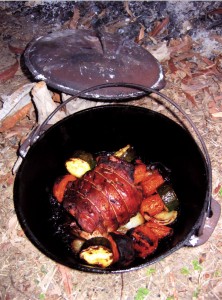
Sadly it’s getting harder in this day and age to have a camp fire. But when you can, a rolled shoulder of lamb and veggies makes a great camp oven roast dinner.
I put a small roof rack on the 4WD, mainly as a platform for firewood. These days, for sensible environmental reasons you cannot gather even dead wood in national parks or camping reserves and in order to have the luxury of a camp fire where you are allowed, it is sensible to pick up wood from beside the road before arriving.
The Manor had a 60 litre water tank, and behind the rear bumper bar we carried an extra 20 litre jerry can that was filled when necessary. We always have a 5 litre container of water in the back of the 4WD as well for safety and convenience. There is a second bracket at the rear of the camper for a 20 litre fuel jerry can, used to bridge long hauls. The Landcruiser has a main tank of 90 litres, and a reserve of 50 litres. Normally we would expect to get nearly 1000 kilometres from this, but towing pegs that back considerably. Even with the extra jerry can of diesel I would not expect to get more than 800 kilometres towing The Manor between refuelling points.
We carry two folding tables and two camping chairs behind the front passenger seat. One table does us for lunch stops and two are handy in camp where we spend as much time cooking and living outside The Manor as possible. There is a canvas awning easily pulled out, Ros cooks on a single gas-fuelled burner on one table and we eat our evening meal on the other. In wet or windy weather we have the luxury of cooking and eating inside. Ros says we almost certainly carry too much but, on the other hand, camping is not really about deprivation, it is about indulgence.
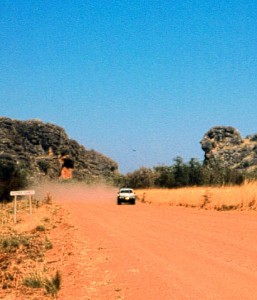
This section of the Gibb River Road is famous for the rock formation that looks uncannily like Queen Victoria.
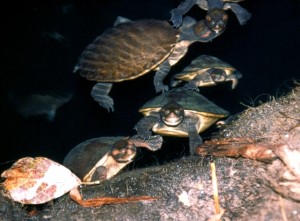
These charming little ‘Ninja’ turtles were photographed at night in Bell Gorge, near El Questro Station, on the Gibb River Road.
And so, Penelope Headed North…
IF YOU WOULD LIKE TO COMMENT ON THIS ARTICLE OR ANY OTHER PAGE ON THIS WEBSITE PLEASE USE THE CONTACT BUTTON UNDER THE HEADER BAR.
Available to purchase for $28.50 including postage and handling within Australia.
Contact Us to inquire

